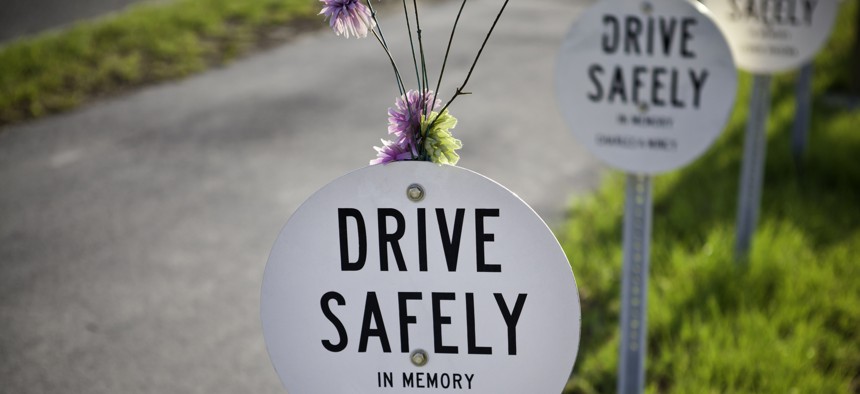Don’t Forget Driver Behavior, Highway Safety Advocates Plead

istockphotos.com/cristianl

Connecting state and local government leaders
A prominent group of state road safety officials urged fellow advocates to focus on changing driver behavior—not just improving infrastructure—to fight a recent surge in traffic deaths.
A prominent group of state road safety officials urged fellow advocates to focus on changing driver behavior—not just improving infrastructure—to fight a recent surge in traffic deaths.
The Governors Highway Safety Association issued a report Wednesday trying to make sure that traditional safety messages don’t get lost as more people get interested in changing roads to make them safer.
Efforts to combat drunk driving, improve seat belt use and discourage drivers from speeding are still needed, the group argued.
“Emphasizing one approach does not mean we should discount others,” GHSA executive director Jonathan Adkins wrote in the report. He stressed the need for advocates to use a “safe system” approach, one that includes many different approaches, including enforcing existing laws, educating drivers and engineering streets to minimize crashes. The idea is that the system builds redundancy, to reduce the number and severity of traffic crashes.
“The Safe System is meant to be a systematic approach and it will be unachievable if we de-emphasize or willfully ignore parts of the system,” he wrote.
The group’s message comes at a crucial time. The number of people who died in traffic crashes in the first half of 2021 increased by 18% over the same period in 2020. There appear to be multiple reasons for the spike, including drivers traveling at higher speeds and being less likely to wear seat belts since the beginning of the pandemic.
The GHSA report encourages state highway safety offices, which make up the membership of GHSA, to promote efforts to change driver behavior. That includes their traditional job of running education and outreach campaigns, as well as outreach to the staff of state agencies and to the public about the importance of all aspects of the safe systems approach.
At the same time, though, GHSA cautioned against advocates going overboard in increasingly popular approaches like Vision Zero that stress the importance of changing infrastructure to make streets safer. Those movements have led to the growing popularity of protected bike lanes, pedestrian islands and narrower vehicle lanes, which protect non-motorists and encourage slower vehicle speeds.
That has sometimes led to a “disconnect,” GHSA said, over whether traditional campaigns about driver behavior belong in those new approaches.
“On one hand, [the focus on Safe Systems] has reframed and revitalized interest in traffic safety, brought new voices to traffic safety discussions, identified infrastructure shortcomings and promoted the need for a stronger sense of shared safety responsibility in infrastructure planning,” the group wrote.
“On the other hand,” it added, “some Safe System discussions have prioritized infrastructure at the expense of other countermeasures proven to positively impact safety. It has also created divisions within the safety community that undermine the shared pursuit of safety goals.”
“It is difficult enough creating a sustained sense of urgency about safety without professionals and advocates arguing with each other,” the group warned.
‘Nervous’ About Emphasis on Driver Behavior
But Beth Osborne, the director of Transportation for America, a group that has called for major changes in the country’s street designs, such as the ones outlined in this report, to promote safety, said GHSA’s continued emphasis on changing driver behavior made her “nervous.”
“We have focused 0% on design throughout the history of the [highway] program and 100% on education and enforcement,” she said. “Every time we suggest that we shift to a third, a third, a third, everyone asks: What about behavior?”
Street design can influence behavior by encouraging drivers to move slower, Osborne argued, and that could give them time to see and avoid potentially dangerous situations.
“Yes, we should definitely make sure people wear seat belts and have laws that encourage it. But wouldn’t it be great if they don’t need that seatbelt to save them, because they’re not in a crash at all?” she said. “Where speeds are lower, crashes are fewer and they’re less deadly for everybody, even the unbelted person [like pedestrians or cyclists] outside of the vehicle.”
The difference in street designs makes a difference even if drivers are making poor choices, because they’re going slower. That’s why deadly crashes are more likely to happen in places where motorists can go fast in places where there are lots of conflicts, like cross streets, driveways and people who aren’t in vehicles, she explained.
While some education of drivers and non-drivers is necessary, Osborne argued, infrastructure improvements can have a longer-lasting effect. “Do I think we should be spending as much on teaching people how to behave in a fundamentally unsafe system instead of fixing the system? No,” she said.
On the other hand, Osborne said she was encouraged that GHSA and other highway agencies are talking more about the need for infrastructure improvements as part of a Safe Systems approach.
“They are headed in the right direction, and that is important, because they are leaders in safety,” she said.
“The next step we need to move into, if we’re all going to be on the same page, is [determining] how: What has to change to implement a Safe Systems approach? What in our current design is not a safe system?” she said. “That’s going to be a painful conversation, but if we can take that next step together, we’re going to get some real work done. We’re going to save some lives.”
Daniel C. Vock is senior reporter for Route Fifty.

NEXT STORY: Infrastructure Update: Governors Try to Unclog the Supply Chain





